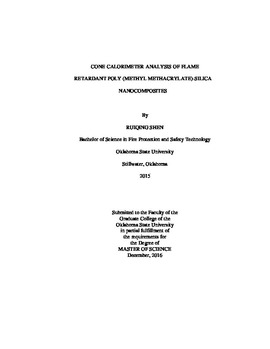| dc.description.abstract | Flame retardant additives, such as phosphorus-based fillers, metal hydroxides, metal carbonates, and nanocomposites, have been considered as the most common methods to reduce fire hazards of polymers. Specifically, polymer nanocomposites have an advantage in reducing fire hazards efficiently even when the additives are at such a low concentration as 5 wt% or less, like nanoclay and carbon nanotubes. Nanoscale silica particles are a relatively new type of nanofiller. Moreover, in theory, crosslinking between the polymer chains by forming additional covalent bonds, can enhance char formation of polymeric materials to further promote their flammability, because crosslinking creates a carbon-dense structure that is not easy to be volatilized. In this study, crosslinked and non-crosslinked polymer nanocomposites composed of low concentration of silica-containing flame retardants have been prepared via the in-situ method of embedding nanoscale silica particles into the poly (methyl methacrylate) matrix (PMMA). The nanocomposite samples were tested by using the cone calorimeter at the heat flux of 50 kW/m², and their corresponding fire behaviors under forced-flaming conditions were evaluated. Although silica-containing flame retardants tend to negatively affect the ignitability and soot production especially at a high concentration, through the condensed phase mechanism, the samples of high loading rate of nanoscale silica particles show better fire retardancy performance in the aspect of flammability, like decreased heat release rate, mass loss rate, total heat release, flame development and spread. Additionally, at the low concentration of nanoscale silica particles, crosslinking was observed to contribute to the better flame retardancy of crosslinked PMMA samples in a certain aspect, like the lowered intensity of combustion. The combination of nanoscale silica particles with the modification of the internal structure of the polymer nanocomposites might be a strategy to improve fire retardancy. | |
